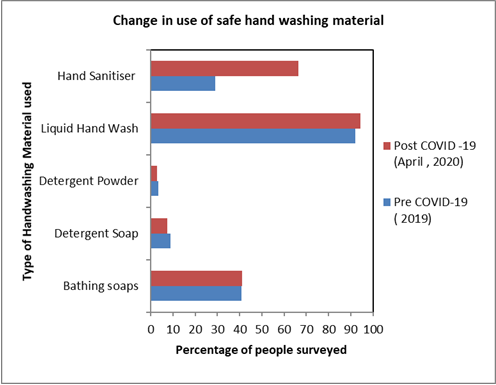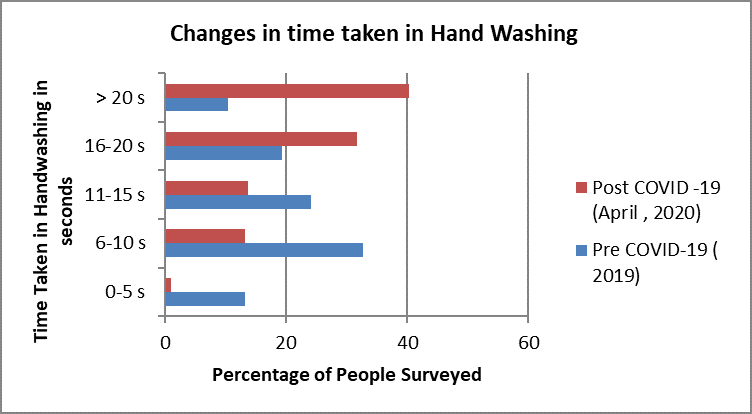COVID-19 – leading to behavioural change in handwashing?
COVID-19 and Safe Hand Washing- What has changed for the urban middle class in Northern India?
As India went into lockdown in March 2020 due to COVID-19, I was sitting in home contemplating what I can do in this lockdown situation to know more about the complex issue of behavior change communication in Water, sanitation and Hygiene sector, that I had been working on for the past couple of years. This was when I called up my mentor and guide Mr. Puneet Srivastava, a member of the International Water Association, who is working with WaterAid to seek his thoughts on the same. What he came out was the suggestion that why don’t you study what has changed in terms of Safe Hand Washing behavior of the people in light of COVID-19. He also suggested doing this online survey on people who are exposed to social media and other mass media campaigns that focused on safe hand washing as critical measure to fight COVID-19 and have access to enough, water and soap, etc. This became the basis of a study, under his guidance, undertaken using a survey which was responded by 211 people from North Indian states of Delhi, UP and MP, conducted between 23April to 26 April 2020. Almost a month into the lockdown period in India due to the spread of COVID-19.
A girl washing hand with soap in district Banda, India and one of the respondents of the survey | Photo Credit: Prashansha Gupta
We wanted to check out what has changed in behavior related to safe hand washing in this group from Pre-COVID-19 outbreak times.
We asked these 3 questions and answers by respondents gave us insights into behaviourial change programme and communication strategies on safe handwashing practices which might be immensely useful for professionals working in WASH (Water, Sanitation, and Hygiene) sector.
The first question asked was – How the handwashing practices at critical times has changed pre-COVID-19 and during COVID-19 pandemic times after one month since the outbreak?
The main findings on this question were that even though there has been a massive increase ( up to 60%) in overall hand washers with soap at different occasions, the time when they think safe hand washing is necessary to fight COVID-19 risk is largely perception-based creating a lower level of confidence on the sustainability of behaviour change related to safe hand washing.
The second question asked to respondents was- How much is the time taken on average in each hand washing has changed during Pre-COVID-19 and during COVID-19 pandemic times after of one month since the outbreak?
The results are shown in the graph as below. The key finding was that even though in general there is an increase of timing for handwashing to make it safer, , 60% of the people are washing hands with soap within 20 seconds of prescribed minimum time essential to complete safely six steps of safe hand washing. They continue to remain at 100% risk of catching the infection from their hands despite their, so-called, safe Hand Washing with soap.
The third question asked to respondents was -Has there been some change in the items which people use for safe hand washing Pre COVID and during COVID pandemic times?
The results of feedback received are shown in graph as below.
There has been a phenomenal increase ( 29% to 66%) in percentage of people using Hand Sanitizers and liquid soap remains most popular option ( 94% people use it). The drastic increase in percentage of people ( by 37%) adopting to hand sanitizers seems to be picking up as an alternative to safe hand washing through soap and clean water. Sanitizers are an option only when soap and clean water are not available for safe hand washing such as while travelling. It does not matter if you use a normal soap or germicidal soap/ sanitizer/ liquid hand wash or a normal one. But the zeal to overuse them has started hurting communities in developed world and we should learn from that experience . Antibiotic resistance in all parts of the world is new buzz world in health sector. Long-term exposure to certain active ingredients used in antibacterial products — for example, triclosan (liquid soaps) and triclocarban (bar soaps) — could pose health risks, such as bacterial resistance or hormonal effects. Therefore , overuse of anti- microbial soaps and sanitizers that contain triclosan or triclocarbon should be avoided.




